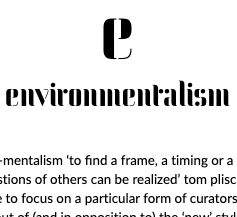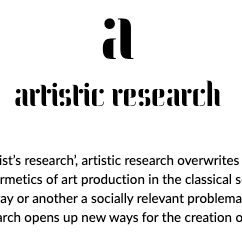institute

institute
THE TENDER INSTITUTE
In the whirlwind of changing subsidy policies, and political crisis, the Institute has become a partner to be mistrusted. What has become clear from all the waves of institutional critique that have fueled the visual arts production in the last decennia, is the Institute’s extreme flexibility to reinvent itself, to recuperate and produce the ruling discourses, in a constant craving for the new. The Institute in this understanding has become synonymous with capital power struggles, with normative regulation of the arts scene, and with an unsavory attachment to a global economy that creates and sustains inequality, poor labor conditions and a sanctimonious elitist attitude towards knowledge and its distribution.”
Who’s afraid of the Institute?
In the whirlwind of changing subsidy policies, and political crisis, the Institute has become a partner to be mistrusted. Paraphrasing Dorothy Parker you could say that the Institute in most contemporary engaged art practices is ‘not one to be tossed aside lightly. It should be thrown with great force.’ What has become clear from all the waves of institutional critique that have fueled the visual arts production in the last decennia, is the Institute’s extreme flexibility to reinvent itself, to recuperate and produce the ruling discourses, in a constant craving for the new. The Institute in this understanding has become synonymous with capital power struggles, with normative regulation of the arts scene, and with an unsavory attachment to a global economy that creates and sustains inequality, poor labor conditions and a sanctimonious elitist attitude towards knowledge and its distribution.
In the last ten years however, more and more artist initiatives have been re-thinking the Institute’s mandate. Taking the term up on its potential, rather than its historical accomplishments, the Institute once again has become a point of address: a specific place where people share their concerns and interests, where you can find topical information and engage with it, where knowledge is archived and opened up to public interest and scrutiny. Although it is a bit of a stretch to compare all these particular initiatives, I will venture to formulate some comments on these practices that place them within a larger field of enquiry in today’s art field.
Compared with the more established Institute’s the arts’ initiatives seem less embedded in a universal idea of knowledge conservation than in a dynamic reformulation of knowledge processed in situ. In that sense we could use the term ‘environmental’ for these newly constructed spaces for encounter. The environment here is constructed by the relations and the interests of the people participating in the particular context (of the Bureau, the performance, the work table, etc..). In other words: the institute (without capital I) has lost its clear horizon of social valorization and functionality. It is not transparently embedded in a supra-structure of similar houses of power. Instead it has a nomadic feature that is permeable, a qualitative openness that connects it directly to a context of particular participants, diverse spaces and a larger politico-social context.
Another important feature of this institute is that it allows for a differential approach of interests. Although the institute clearly functions as a point of address of a certain problematics, as an environmental space, the processing of this information can be shared by anyone participating. Turning the monolithic space of recognition and representation into a heterotopic openness to different interests. What we see here is a constantly shifting maze of connections and reconnections, allowing for a constant and simultaneous shrinking and aggrandizing of the issues addressed. Connecting now only with a group of 4 participants, and at the same time addressing a global or political question that overrides by far the mandate of the artistic initiative at hand.
The institute’s boundaries in that sense are highly flexible, but not in the way they’d adapt to whatever kind of interpretation. Like in any other institute – and especially in the Tender Institute – the practices and the encounters are prescribed. There is an etiquette ruling the space that makes it possible to engage. There is an invitation that opens up the potential of the encounter. But at the same time the level and focus of engagement stays open for interpretation. For the mutual recognition of a common interest. Based on the smallest of details, or on the largest of analytical frameworks. The institute in that way questions our ‘sense of belonging’, of being part of the event unfolding: do I engage in the practice as an artist, a citizen, a woman, an agnostic or a believer? What does this engagement then produce in the event? How do I relate to the information that is swirling around? How do I add (or not) to the particular context unfolding?
Infolding the Institute
The institute (I make the distinction between the Institute as the power house and the institute as the environmental settlement) is a particular space, situated not outside of the logics of classification and order, but standing at its limits, ‘at the edge of the void that lies beyond every order of recognition or normalization’ (professor Peter Hallward on Foucault’s use of the specific). It is this de-normalization process that is of interest to the artist community rethinking its own complicities. All too often the engagement with ‘what lies outside’ of the arts is taken up on the level of the reinstallment of an oppositional logic of understanding. In the embrace of a politics of trying to understand the other (the precarious worker, the poor, the immigrant, …) the artistic practices process and produce again and again this dichotomic sense of ‘normalcy’ in contrast to the ‘exotic’ feature of the have-nots, not taking into account the complicity in the construction of exactly these knowledge divisions, these ‘states of exceptions’ that sustain an unequal access to the declaration of ‘what is important’, today as well as in history or in the near future.
What the institute can do is exactly to redefine the grid that limits our entitlements of knowing and taking action. Turning the strictness of the dividing horizontals and verticals in an interesting plane of ‘wholes and holes’, for every individual to navigate through. What the institute archives in these circumstances, is then not a universal, nor even a particular kind of knowledge. Rather it archives the processes that keep these different knowledge field connecting and communicating. The institute expresses a desire to address, to weave a grounding but fragmentary mythology for the becoming of the social fabric. No longer a clear road map to navigate our relations in past, present and future, the institute infolds the very diverse ways to deal with the ‘situation’, with what we think is at stake in this slice of time and space.
Methods and tools
If we said earlier on that it is a precarious endeavor to put all recent artistic institute’s projects on the same line of interpretation, that is largely because all these initiatives claim a particular and concrete point of departure and an other methodological logic. In all their quirky singularity they break the demand for seamless reproduction that governs still a big part of the arts scene. The development of work here is drawn out of its mold of quantifiable recognition (through number of performances, partners, spectators and critiques) and into a much murkier field of the development of ‘qualities’ of working and sharing a space for exchange. As we know every method of work is somehow reproductive of a certain world view, of a particular way of relating to your collaborators, of a certain way to understand what ‘work’ today can still mean. Aesthetics are in that sense always prescriptive, or even – in some cases – normative, in the explicit demand that the situation should be recognized, and the division of roles that this implies. The art work here could be seen as an interface of social relations to unfold in the encounter. A relationality that can reach far beyond the limits of the arts factory.
If we understand the institute as a possible tool to deal with these relations, this is not a tool that is to be judged by its efficiency, by the results that it provides. Rather, the tools used by the institute are at the same time highly specialized and highly dysfunctional. You might say that a good tool in this context is not a tool that hides itself behind its own surefire functionality, but rather one that talks back. A tool as an obstacle, as something that has to be reckoned with. Undermining as much as opening up the process of relating and dealing with the situation. As Isabelle Stengers mentions in her ‘Ecology of Practices’: “This is how I produced what I would call my first step towards an ecology of practice, the demand that no practice would be defined “like any other”, just as no living species is like any other. Approaching a practice then means approaching it as it diverges, that is feeling its borders, experimenting the questions which practitioners may accept as relevant, even if they are not their own questions, not insulting ones leading them to mobilize and transform the border into a defence against their outside.”
In that context the tool functions rather as a ‘symptom’ of the way we perceive our being together. Of the ways we consider an object, a situation, a relation, as a piece of knowledge to be dealt with. Every environment constructs its own value system. Not on the basis of a mutual agreement, but on the practical basis of ‘what works’ or ‘what doesn’t work’. In other words: what creates a situation is a change in the status quo, a performance. Opening up the method to the participants (both the ‘users’ of the institute as the creators) makes it possible for anyone to rethink its metabolism, its inner working, its outer organizing affect. Instead of the ideological reinforcement of the hierarchic status quo proposed by the Institute, the institute reappraises the circulating mythologies that cross the space, the specificity of the current proposal, the value of what is to be kept alive for the future (performances). The institute is what turns a ‘state of exception’ into a ‘state of attention’ for everyone to appraise.



